
Now, especially, the point seems so obvious that it's hardly worth stating. Still, in an era of political doublespeak and misread texts secular and divine, the Sharjah Biennial 10: Plot for a Biennial, curated by Suzanne Cotter, Rasha Salti, and Haig Aivazian, confirms that biennials and the sites that stage them must be historically engaged and spatially meaningful.

In both texture (an ordered clamor: gritty, raucous, exuberant) and tenor (oracular, statesmanlike), this exhibition represents the aesthetic equivalent of Cairo's Tahrir Square. Though each piece created by more than 80 artists from 36 countries may be based on each individual artist's creative personality and life experience, their convention in a particular place - Sharjah, cited by UNESCO in 1998 as the Arab world's cultural capital - at this particular time - who could have predicted that, the week prior, the United Arab Emirates, along with Saudi Arabia, would send troops to Bahrain? - shows that art and its infrastructure must do what politicians and statesmen can not: state an urgent truth in a language that everyone can understand.
Though the arrayed voices range from the strident to the humorous to the transcendent, it's how these voices are organized that confers significance to the exhibition. Despite the sheer quantity of artists and work, this Biennial feels like a series of one-person exhibitions, screenings, and concerts that, taken together, sound more like an interdenominational Kyrie of let the people speak.
Girded by a curatorial concept based on themes of treason, trade, and translation, each artist becomes a plot-maker, which gives the enterprise both cinematic and conspiratorial undertones. Housed in the Sharjah Art Museum proper or distributed among outlying buildings and public - some historic - spaces, including several created for the event, the exhibition includes visual art, film, choreography, music, and video, featuring over 65 Biennial-commissioned pieces.
Each piece, whether it's housed in the Arts Area or the Heritage Area, whether it's part of the art or the cinema program, whether it's that magnificent three-evening Score for a Biennial, shows a response of artists to a world in which language belies purpose, in which disjunctions exist between the content, form, and purpose of texts, be they sacred and secular, political or militaristic, personal or societal.
Showing yet again that painting, drawing, etching, photography, sculpture, mixed media, installation, and site-specific work are mightier than the sword, this exhibition confers upon art the status of a pliable, articulate, and universal language. And what better time than now? The best pieces are those that expose this chicanery of empty words. Overall the ensemble effort proposes that actions (mark-making, as well as protests, denunciations, and documentation) are more important than words, that the collective efforts of individual artists can rise above sectarian, tit-for-tat violence and unrest and attract art world, if not world attention, if only but for the duration of eight weeks.
The Curators situate this Biennial on contrasting atmospheres in which things appear to be one thing but prove to be something else. It operates on a dynamic between the traditional, timeless, and sacred versus the engaged and called-upon-to-act. The tranquil settings belie the various operations intrinsic to each work.
These atmospheres can be played out in such a piece as Imran Qureshi's Blessings upon the Land of My Love. Though it looks at first like assassination blood splattered in a courtyard (whose doorways, windows, and arches resemble coffins and grave pits), upon closer examination it describes tendrils of roseate flowers.
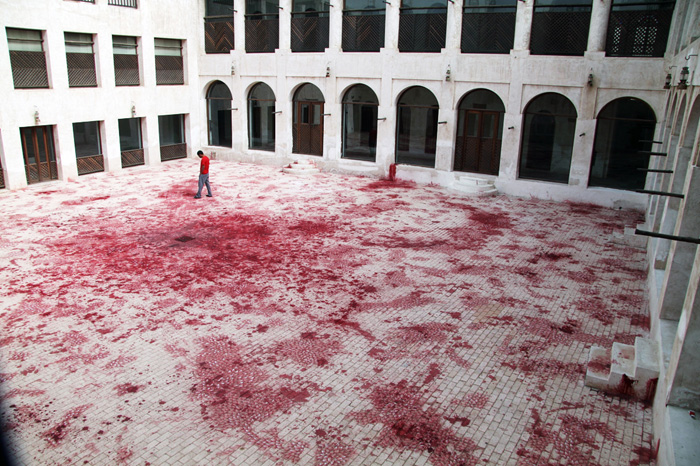
Imran Qureshi, Blessings Upon the Land of my Love 2011 | Site-specific installation, emulsion and acrylic on brick
Or a piece like Hrair Sarkissian's Execution Squares, images shot at dawn of Aleppo, Lattakia, and Damascus, three seemingly innocuous Syrian cities that represent prior sites of public executions.
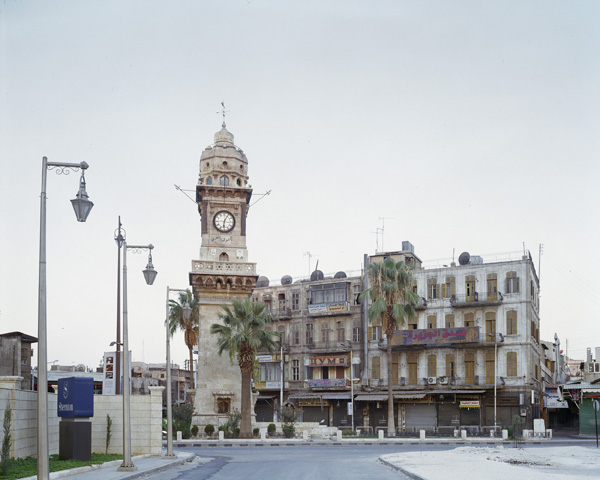
Hrair Sarkissian, Execution Squares 2008 | 12 Lamda prints mounted on aluminium
It can appear, as with Judith Barry's Cairo Stories, audio and video tales of the experiences of Cairene women, as if out of nowhere, in souks, at the heads of narrow stairwells, and on building walls. Once you encounter one of these women, pleasant if unexpected, they seem to be everywhere, a point not necessarily afforded their real existence.
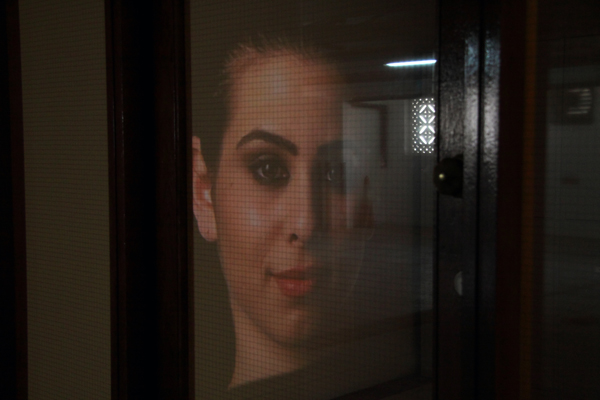
Judith Barry, Cairo Stories, 2010-11 | Multi-site video installation
The message can be in your face and unrealized, as with Hans Haacke's Calligraphie, Here. In a call to art to commemorate the bicentennial of France's Assemblee National, he proposed a piece that would script the Republic's motto, "Freedom, Equality, Fraternity" in Arabic, a wry, blunt comment on their treatment of its Moslem population. Though the proposal wasn't accepted - duh - the gesture and thought behind it are what matter. The rejection, in fact, was the project's confirmation of the message.

Hans Haacke, Calligraphie, 1989/2011 | Photos, text
Same with Joana Jadjithomas and Khalil Joreige's Lebanese Rocket Society: Elements for a Monument, which documents the country's effort to develop a rocket program in the early '60s. Though intended solely for research purposes, the project ended in 1967. The various documents inside and the installation outside the front of the Museum of a Cedar 4 rocket suggest the excitement for progress and the idealism of apolitical science, as well as the potential for the more sinister applications of said technology.
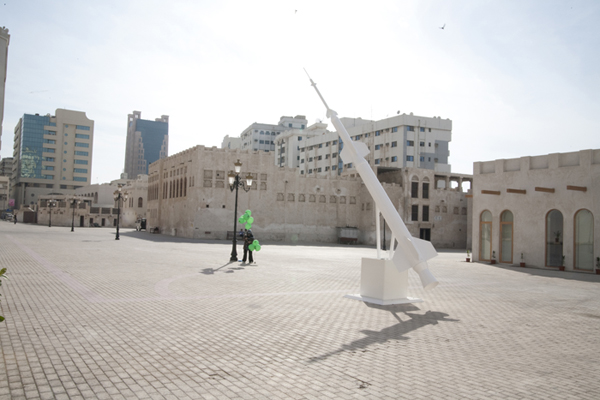
Joana Hadjithomas and Khalil Joreige, Lebanese Rocket Society: Elements for a Monument 2011
It can be inclusive but sly, as with Shoreh Mehran's School Girls. Though she depicts a trio of school girls with Durer-esque exactitude, you look at them from behind, suggesting the best place for a culture to to hide something, someone, is in plain sight.
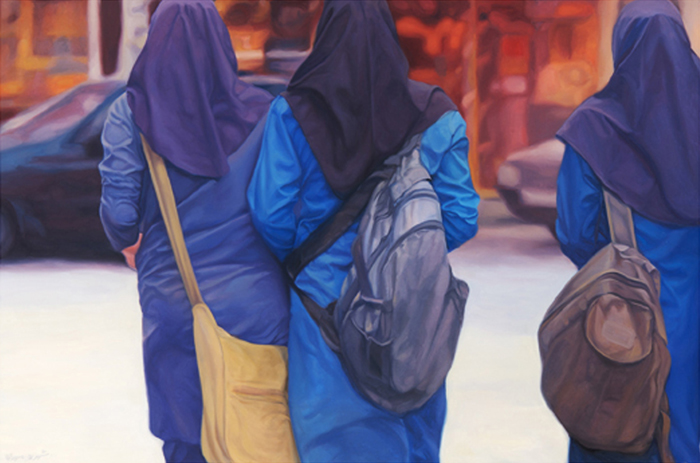
Shohreh Mehran, School Girls 2009-2010 | Series, oil on canvas
As with Aisha Khalid's Kashmiri Shawl. On one side it pins inserted through two shawls, resulting in lovely if labor intensive floral designs. On the back side, however, it the prickly tips of the pins, suggesting the effort that went into its creation as well as the more spiritual ideas of either a crown of thorns or a hair shirt.
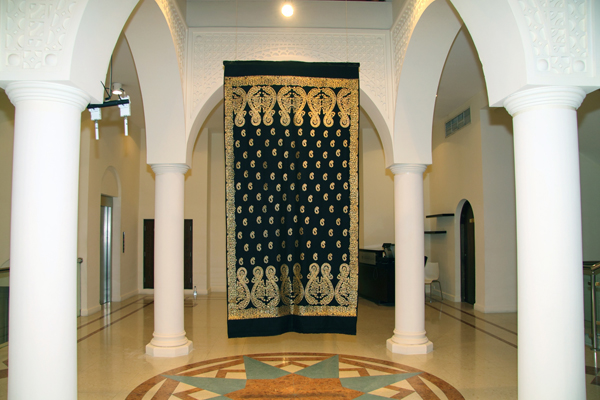
Aisha Khalid, Kashmiri Shawl, 2011 | Site-specific installation, pashmina scarf and gold plated steel pins
It can be exclusive but sly, as with Tom Molloy's Subplot. A serpentine that runs along the gallery's wall, it includes 235 drawings that only includes the bits of George Orwell's 1984, that refer to a romance secondary to the plot between one Winston and Julia. The piece suggests an exaggerated sense of reading between the lines and alludes to wily, misappropriated, perhaps harmful mis-readings of literature for other purposes.
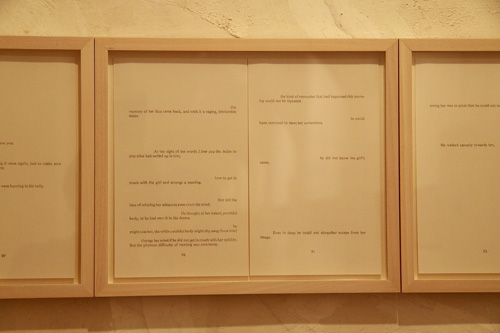
Tom Molloy, Subplot 2008 | 117 framed drawings, pencil on paper
More than anything else, this magisterial exhibition represents a political act, a declaration of artistic independence (and identity: I create, therefore I am), a line drawn in the desert sand; the opposite of which would be to do nothing: no art, no biennial. To do nothing would be the greatest shame of all.
The exhibition runs until May 16. For more information visit www.sharjahart.org.
ARTISTS
Jumana Emil Abboud
Youssef Abdelké
Ebtisam Abdulaziz
Adel Abidin
Atfal Ahdath
Hala Al-Ani
Abdullah Al Saadi
Ziad Antar
Doug Ashford
Vartan Avakian
Yto Barrada
Judith Barry
Shumon Basar, Eyal Weizman, Jane and Louise Wilson
Bahar Behbahani
Mustapha Benfodil
Alexis Bhagat and Lize Mogel
Anna Boghiguian
Ammar Bouras
Dan Brault
CAMP (Shaina Anandand Ashok Sukumaran)
Guillaume Cassar
Marie-Hélène Cauvin
Jem Cohen with Luc Sante
Ziad Dalloul
Raffie Davtian
Decolonizing Architecture Art Residency
Trisha Donnelly
Harun Farocki and Andrei Ujică
Simone Fattal
Mariam Ghani
Ahmed Ghossein
Hans Haacke
Joana Hadjithomas and Khalil Joreige
Ramin Haerizadeh
Rokni Haerizadeh
Gilbert Hage
Khalid Hourani
Richard Ibghy and Marilou Lemmens
Hatem Imam
Alfredo Jaar
Emily Jacir
Amar Kanwar
Aisha Khalid
Bouchra Khalili
Mark Lombardi
Newsreel Archives of Soviet Television
Josephine Meckseper
Shohreh Mehran
Julia Meltzer and David Thorne
Almagul Menlibayeva
Naeem Mohaiemen
Bahman Mohassess
Tom Molloy
Houman Mortazavi
Fateh Moudarres
Jean-Luc Moulène
Rosalind Nashashibi
Melik Ohanian
Imran Qureshi
Walid Raad
Khalil Rabah
Walid Sadek
Hrair Sarkissian
Matt Saunders
Samir Sayegh
Kamran Shirdel
Slavs and Tatars
Rania Stephan
Rayyane Tabet
Jorge Tacla
Jalal Toufic
Apichatpong Weerasethakul
Raed Yassin
Elias Zayat
Artur Żmijewski
